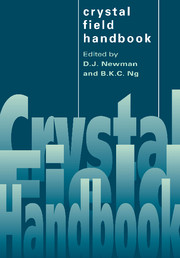Book contents
- Frontmatter
- Contents
- List of contributors
- Preface
- Introduction
- 1 Crystal field splitting mechanisms
- 2 Empirical crystal fields
- 3 Fitting crystal field parameters
- 4 Lanthanide and actinide optical spectra
- 5 Superposition model
- 6 Effects of electron correlation on crystal field splittings
- 7 Ground state splittings in S-state ions
- 8 Invariants and moments
- 9 Semiclassical model
- 10 Transition intensities
- Appendix 1 Point symmetry
- Appendix 2 QBASIC programs
- Appendix 3 Accessible program packages
- Appendix 4 Computer package CST
- Bibliography
- Index
5 - Superposition model
Published online by Cambridge University Press: 10 December 2009
- Frontmatter
- Contents
- List of contributors
- Preface
- Introduction
- 1 Crystal field splitting mechanisms
- 2 Empirical crystal fields
- 3 Fitting crystal field parameters
- 4 Lanthanide and actinide optical spectra
- 5 Superposition model
- 6 Effects of electron correlation on crystal field splittings
- 7 Ground state splittings in S-state ions
- 8 Invariants and moments
- 9 Semiclassical model
- 10 Transition intensities
- Appendix 1 Point symmetry
- Appendix 2 QBASIC programs
- Appendix 3 Accessible program packages
- Appendix 4 Computer package CST
- Bibliography
- Index
Summary
Calculations of crystal field parameters from first principles depend upon a knowledge of the crystal structure in the immediate neighbourhood of the magnetic ion. The calculated crystal field contributions for single ligands (see Chapter 1) can then be combined to estimate values of the crystal field parameters for real systems. Most calculations of this type [New71] have been based on the assumption that the combination process is purely additive, i.e. that the ‘superposition principle’ holds. At the present time, however, the superposition principle is mostly employed in the analysis of experimentally determined crystal field parameters. This phenomenological application is known as the ‘superposition model’.
This chapter, taken together with some of the QBASIC programs described in Appendix 2, is designed to provide a comprehensive ‘Do It Yourself’ kit, supporting various applications of the superposition model in the calculation and interpretation of phenomenological crystal field parameters. The mathematical manipulations are relatively simple; some can even be carried out by hand using tables provided in this chapter.
Section 5.1 summarizes the physical assumptions that underlie the superposition model. It also gives the basic equations that describe the model and lists the various ways in which the model can be applied. A comprehensive survey of the empirical values of the intrinsic, or single-ligand, crystal field parameters is given in Section 5.2. Practical means of simplifying superposition model analyses, together with some examples of the use of the model to estimate empirical crystal field parameters from the intrinsic parameters, are described in Section 5.3.
- Type
- Chapter
- Information
- Crystal Field Handbook , pp. 83 - 119Publisher: Cambridge University PressPrint publication year: 2000
- 12
- Cited by

